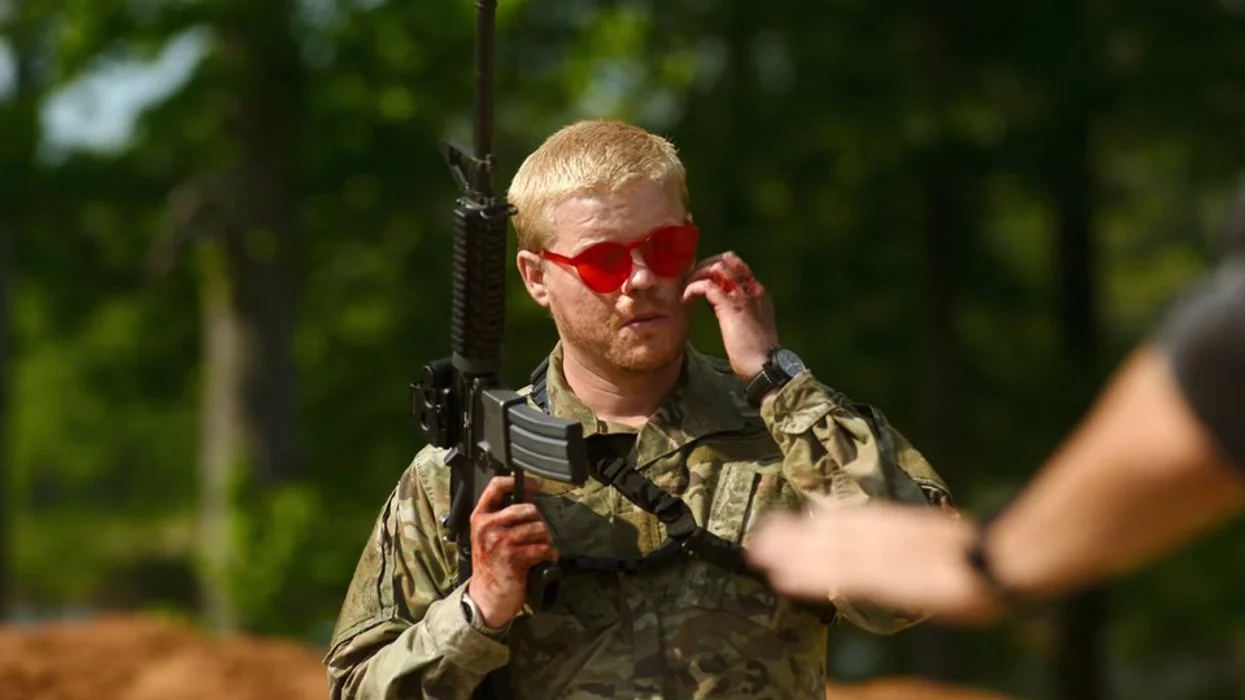
A24

Maybe it could happen here — but isn't anyone curious enough to ask how?
Is it really that hard to be a photographer? Maybe this is just the resentment of someone who gets paid by the word, but to me, it looks like all you have to do is point and shoot.
Compared to that, I'm digging ditches over here.
Had Garland spent his $50 million budget on making the kind of libtard, death-to-muh-democracy fever dream that's been stupefying half of the country since 2016, he would've had a "Battlefield Earth"-level camp classic on his hands.
The protagonists of Alex Garland's new movie, "Civil War," aren't just professional photographers: they're war correspondents. This means they point their cameras at people getting shot or burned alive or blown up or picking a battered teddy bear out of the rubble.
In this case, they don't have to look for the action in some far-flung "s**thole" (as Nick Offerman's subdued but obviously Trump-inspired president/dictator would call it). It's going down right in their backyard.
We first meet veteran photojournalist Lee (Kirsten Dunst) and her Reuters colleague Joel (Wagner Moura) in a slightly more dysfunctional version of New York City, now held by the forces opposing the three-term, FBI-disbanding fascist in chief.
Confusingly, it's also mentioned that Offerman's character has a penchant for ordering air strikes on American citizens, which seems like more of an Obama thing. I suppose the British writer-director can't be expected to know all our folkways.
Lee and Joel narrowly escape death at the hands of an adorable, corn-fed suicide bomber carrying an American flag. In the commotion, Lee reluctantly helps clueless newbie photographer Jessie, who ends up tagging along with the duo — as does their rotund old friend from "what's left of the 'New York Times.'" Ouch. At least they didn't label it "failing."
This opening scene establishes that war photography is on the one hand harder than regular photography, in that you too can get shot, burnt alive, etc., just like those poor saps you're covering. You might even end up in one of your competitor's haunting, potentially prize-winning photos.
On the other hand, it's photography on easy mode: reality does most of the work for you. And soaking up all that human suffering gives you a world-weary gravity you don't find in the average paparazzo.
Sure, getting hanged by your thumbs from a tree branch and whacked like a flesh-covered pinata because you stole some beef jerky for your kids is tough, but have you tried "bearing witness" to it?
"That's the job," as countless battle-scarred shutterbug movie characters have told their naive, young, dewy-eyed protégés — and as the battle-scarred protagonist of "Civil War" tells her naive, young, dewy-eyed protégé.
All the shop talk makes sense, as "Civil War" is at heart a workplace drama. Dunst and her companions have one goal: get to Washington, D.C., to score an interview with the embattled leader before the "Western forces" overrun the White House and end the war.
Despite their job-related stress, Dunst and co. don't seem to have any skin in the game. No spouses or kids. No loved ones on opposite sides.
The regular people they meet along the way — the soldiers fighting for their lives or the refugee families we see fleeing with their worldly possessions in a shopping cart — do. Unsurprisingly, they don't seem to care whether or not our intrepid professionals achieve their career goals. Neither, after a while, does the viewer.
It's all very effectively done: harrowing urban combat, menacing rednecks with "assault rifles," real-life Dunst-hubby Jesse Plemon in those red sharpshooter shades. If the point is "war is hell," consider it made. Although, there's nothing here Steven Spielberg didn't do better 25 years ago in "Saving Private Ryan."
And that better be the point, as the movie has nothing to say about our current political divisions. Take away the burned-out shopping malls and the assault on the Lincoln Memorial, and the "Civil War" might as well take place in Bagdad or Odessa.
Had Garland spent his $50 million budget on making the kind of libtard, death-to-muh-democracy fever dream that's been stupefying half of the country since 2016, he would've had a "Battlefield Earth"-level camp classic on his hands.
The ragtag squad of trans lesbians pinned down in a ruined Victoria's Secret by the remnants of the 103rd Hot Gun Girl brigade. The MAGA uncle Thanksgiving table siege. And introducing Keith Olbermann (as himself), killing a Proud Boy with his own tiki torch.
"What's so civil about civil war?" a great American once asked. Garland's violent yet timid movie is a kind of answer.
It's rarely so crass as to reveal the liberal assumptions beneath its polite veneer of impartiality. It produces a few arresting images without ever providing much-needed context. It waxes lyrical about moral ambiguity while refusing to consider the political nature of its own most cherished assumptions.
Could it happen here? Garland and his crew have sufficient skill to make it seem plausible. But why would it happen? What kind of passions could prompt everyday Americans to turn on their neighbors and tear apart the country they all love?
If "Civil War" has any theories, it lacks the courage to state them.
Come to think of it, it makes perfect sense that we're forced to experience this cataclysm solely through the eyes of our once proud fourth estate. Their journey through a divided America is just as maddeningly obtuse and incurious as anything you'd see on CNN.